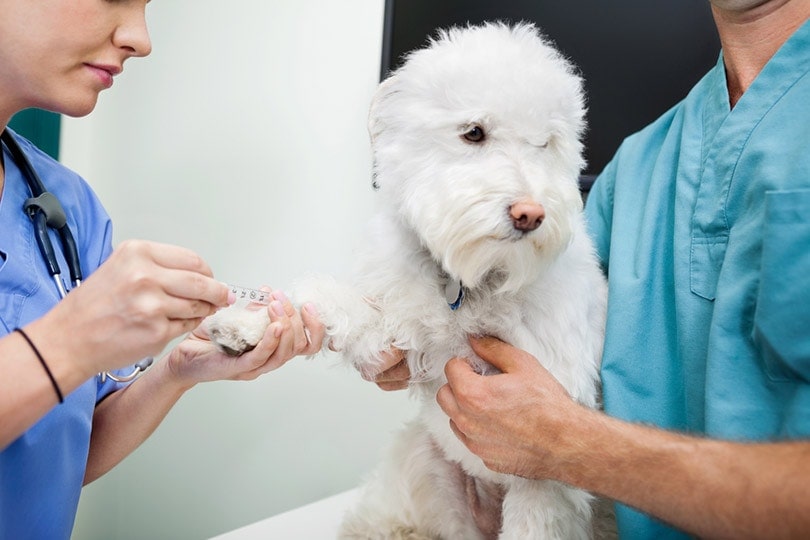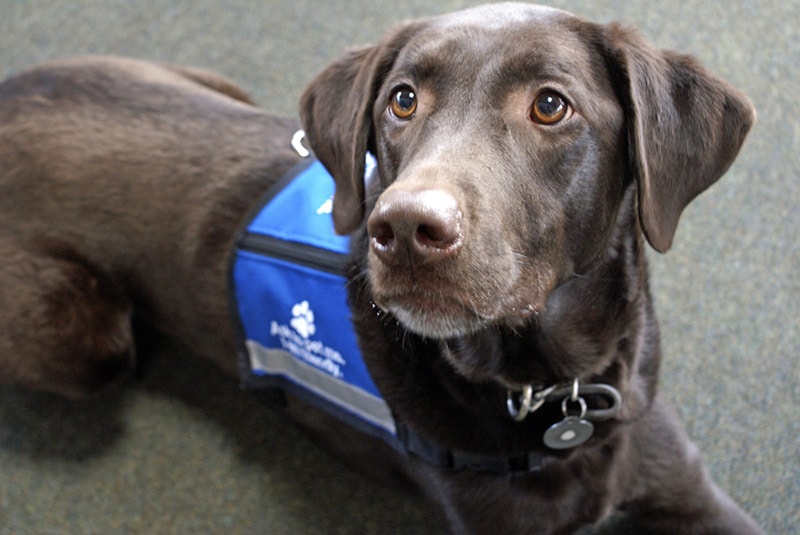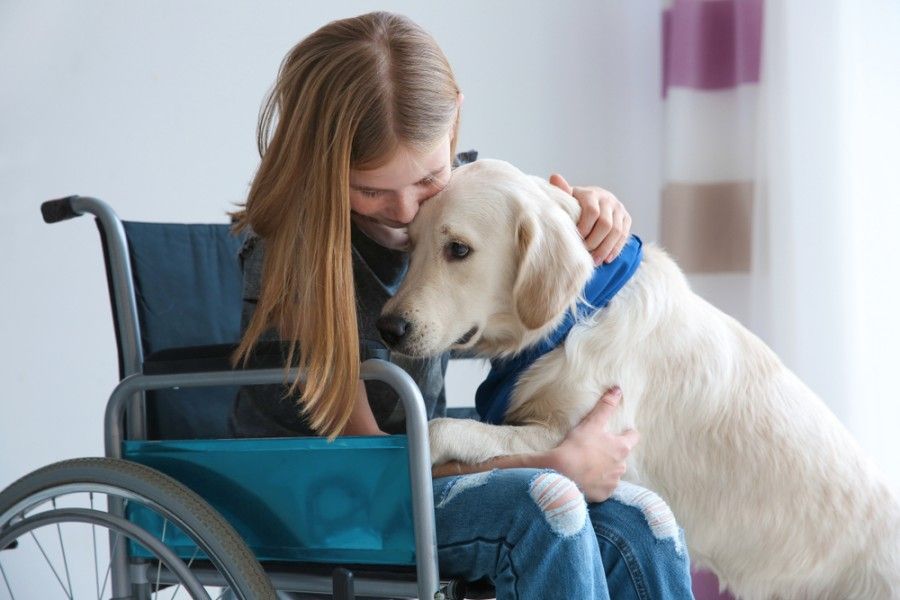What Is a Psychiatric Service Dog? Facts, Types & FAQ

Updated on

Click to Skip Ahead
With the increased awareness of mental health illnesses worldwide, there’s also a growing number of ways to manage the symptoms. One of the ways that are growing in popularity is the use of psychiatric service dogs (PSDs). PSDs are working dogs that are specifically trained to provide essential tasks for their handler.
Although service dogs are gradually becoming more recognized for their abilities, there is still a lot of confusion about what they do and how important they are. Psychiatric service dogs are one of the newest types of service animals and are commonly confused with emotional support dogs and other therapy animals.
Understanding the importance of these dogs and their roles in day-to-day life will help develop an awareness of health issues people can suffer from. Here’s everything you need to know about PSDs from the tasks they do and how they differ from other service animals and emotional support dogs (ESAs).
How Does It Work?
Service dogs are working animals trained to assist people suffering from physical or mental disabilities that interfere with their daily lives. They are trained to provide specific and essential tasks that grant their handler the ability to take part in day-to-day activities. These tasks can range from acting as their handler’s eyes or ears, alerting to medical issues, or helping to manage the symptoms of mental health illnesses.
We’re focusing on psychiatric service dogs in this guide but here’s a quick list of the types of service dogs working today:
- Guide dogs
- Medical alert dogs
- Hearing dogs
- Mobility assistance dogs
- Psychiatric service dog
Although they might look like pets, under the Americans with Disabilities Act (ADA),1 PSDs and other service dogs are working animals. The support they offer their handler is often lifesaving, and they are exempt from the restrictions facing pets in many public areas. This allows them to accompany their handler and assist them wherever necessary.

Psychiatric Service Dogs
A psychiatric service dog, or a PSD for short, is a dog that is specially trained to assist people suffering from debilitating mental health illnesses. They’re often confused with emotional support animals and are often falsely believed not to have the same rights as other service dogs. However, these dogs are just as important in helping their handlers as other service dogs are.
Unlike emotional support animals, PSDs aren’t only a source of comfort for their handler. They also help alert them to oncoming panic or anxiety attacks, perform room searches, retrieve medication, and many other tasks. Like every other service dog, PSDs are trained to provide services their handler has difficulty managing independently.
Breed
When service dogs were first introduced, they were always large breeds known for their intelligence and trainability. Guide dogs and other mobility assistance dogs, for example, are usually large breeds to ensure they can comfortably steer their handler around obstacles or support their weight.
Psychiatric service dogs, on the other hand, can be any breed at all as long as they can meet the needs of their handler. Since the symptoms of mental illnesses can vary from person to person, PSDs often have a much broader range of tasks to complete. A PSD trained for PTSD, for example, would be taught to check that a room is safe before their handler enters, while a PSD for depression would be trained to wake their handler and prevent them from oversleeping.
The most critical factors for service dogs of any type are their temperament and training. Their ability to handle their tasks and be friendly and calm in all situations is of utmost importance.

What Are the Different Types of Psychiatric Service Dogs?
All psychiatric service dogs are trained to help people with mental health illnesses. There are several types of PSD, and they are individually trained depending on their handler’s needs or the specific mental health issue they are dealing with. While some roles a PSD might play can be similar to another, there are a few tasks specific to certain mental health illnesses.
- ADHD
- Anxiety
- Autism
- Bipolar disorder
- Depression
- Phobias
- PTSD
- OCD
This list isn’t all-inclusive, and the dogs are trained to help with many other mental health issues. For now, we’ll focus on the most common types of PSD to introduce how their work differs for each mental health illness.

Anxiety PSDs
One of the most common mental health illnesses is anxiety. A PSD can help manage the issue by noticing the signs or symptoms of oncoming attacks and taking steps to lessen or help you avoid the effects.
- Calm the handler with deep-pressure therapy (DPT)
- Distract the handler during an anxiety attack
- Prevent people from getting too close
- Provide a sense of safety
- Retrieve help if the handler needs it
Depression PSDs
Many people with depression find it difficult to leave their homes or engage in social activities. The presence of a PSD can encourage them to live normal lives by helping them develop routines and helping to promote a healthy level of activity.
PSDs for depression perform tasks such as:
- Helping with daily routines
- Prevent the handler from being too sedentary
- Provide tactile stimulation
- Retrieve medication
PTSD PSDs
Post-Traumatic Stress Disorder, or PTSD, affects people who have experienced highly stressful situations. The scars left behind might not be physical, but they can impact the patient’s way of life. PSDs can help their handler manage the symptoms by performing the following tasks:
- Block people from crowding the handler
- Calm the handler with DPT
- Perform safety checks such as room searches
- Recognize and interrupt destructive behavior
Where Are They Used?
With the increasing awareness of disabilities, including mental health, service dogs are increasing in popularity worldwide. Although guide dogs remain the most popular service dog in many countries, assistance dogs are used for various mental and physical disabilities.
In the USA, psychiatric service dogs are one of many subsets of service animals. Although the laws surrounding service dogs can differ in other countries, the ADA ensures that PSDs have the same rights as other service dogs throughout the USA. Individual states might also have varying laws surrounding service animals, but they all must abide by the ADAs ruling.
Unlike emotional support animals or therapy animals that provide comfort and companionship to their handler, PSDs can accompany their handlers in all public spaces. They’re essential for their disabled handler’s independence and should never be separated from them.
Due to this, you will find service dogs—including PSDs—wherever you find their handler. This includes grocery stores, restaurants, and other areas with no-pet policies.

Frequently Asked Questions
How Do You Qualify for a Psychiatric Service Dog?
Mental health is slowly becoming more recognized as something that needs to be supported and understood. Although it’s one of the most common health issues in the USA, not everyone with a mental health illness qualifies for a PSD.
To qualify for a psychiatric service dog, you need to have been diagnosed with a mental health disability by a trained medical professional. According to the ADA, a person with a disability has a “physical or mental impairment that substantially limits one or more major life activities,” and you must qualify under this definition to be eligible for a service dog, including a PSD.
What’s the Difference Between Psychiatric Service Dogs & Emotional Support Animals?
PSDs and Emotional Support Animals (ESAs) are commonly confused. There is a lot of difference between the two animals and the purpose they serve.
As a service dog, a PSD is trained to provide specific tasks that help their handler regain their independence and live regular lives despite their mental illness. Although they are a source of comfort for their handler, this isn’t the extent of their abilities. They remind their handler to take medication, help them feel safe, and do many other things that help the handler manage their symptoms.
An ESA, in comparison, doesn’t require special training and can only provide comfort for their handler. They are not trained to notice or interrupt anxiety attacks or destructive behavior and won’t remind their handler to take medication. ESAs can also be any domesticated animal, while PSDs are only dogs.
Where Are Psychiatric Service Dogs Allowed to Go?
Due to the importance of service dogs in giving their handler independence, they are allowed to accompany their handler in all public areas. This includes places where pets aren’t allowed. Unless the service dog is out of control, the handler makes no effort to control them, or the dog isn’t house-trained, they cannot legally be separated from their handler. PSDs are service dogs and have the same access rights.

Quick Reference Guide
With their similarities to emotional support animals, it can be easy to confuse PSDs with other types of therapy animals. Here’s a quick guide to help clear the air:
| Psychiatric Service Dog | Emotional Support Animal |
| Trained to perform specific tasks to help their handler deal with mental health illnesses | Provide comfort and companionship to a person with a mental health illness |
| Can be trained by the handler or an organization | Do not require special training |
| Can accompany their handler everywhere under the ADA | Are considered pets and are not protected by the ADA |
| Are only ever dogs | Can be any domesticated animal |
Conclusion
Service dogs are rapidly growing in popularity in treating a range of disabilities. One of the most common issues they handle is mental health illnesses. Psychiatric service dogs are instrumental in helping their handler manage debilitating mental disabilities such as PTSD, anxiety, depression, and much more.
As working dogs under the ADA, PSDs have the same rights as any other service dog and shouldn’t be confused with ESAs. They provide essential tasks for their handler and give them the confidence they need to regain their independence.
Featured Image Credit: Pressmaster, Shutterstock











